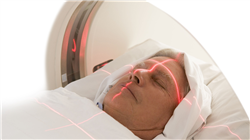University certificate
The world's largest faculty of medicine”
Introduction to the Program
Thanks to this 100% online Postgraduate diploma, you will handle the most innovative techniques of Artificial Intelligence to increase the accuracy of imaging findings and optimize clinical diagnoses”

A recent report by the World Health Organization highlights that the use of Artificial Intelligence in the healthcare field has allowed optimizing the early detection rate of Breast Cancer Tumors by 95%. This fact highlights the potential of these emerging technologies for the early detection of a wide range of pathologies. Therefore, it is important that professionals update their knowledge regularly to incorporate the latest advances in techniques such as Machine Learning into their clinical practice. Only in this way will experts be able to increase the accuracy of their clinical diagnoses and design the most appropriate individualized treatments to ensure optimal patient recovery.
In order to facilitate this task, TECH has created a pioneering program in Image Analysis with Artificial Intelligence for Medical Diagnosis. Conceived by references in this field, the academic itinerary will focus on aspects ranging from the use of Deep Learning in Radiology or the development of graphic interfaces for the exploration of 3D images to Natural Language Processing with Nuance PowerScribe 360. In this way, graduates will develop advanced clinical skills to employ algorithms in Biomedical Imaging to detect subtle features. In addition, the course materials will analyze the most effective simulation and computational modeling techniques for planning complex surgical procedures.
In terms of methodology, TECH provides a 100% online environment that adapts to the needs of busy physicians looking to experience a leap in quality in their professional careers. In addition, it employs its disruptive Relearning system, based on the reiteration of key concepts to facilitate the updating of knowledge. In this sense, the only thing graduates will need is an electronic device with an Internet connection to access the Virtual Campus. There they will find a library of different multimedia resources such as explanatory videos, specialized readings or interactive summaries.
This program gives you the opportunity to update your knowledge in a real scenario, with the maximum scientific rigor of an institution at the forefront of technology"
This Postgraduate diploma in Image Analysis with Artificial Intelligence for Medical Diagnosis contains the most complete and up-to-date scientific program on the market. The most important features include:
- Development of practical cases presented by experts in Artificial Intelligence
- The graphic, schematic and eminently practical contents with which it is conceived gather scientific and practical information on those disciplines that are indispensable for professional practice
- Practical exercises where self-assessment can be used to improve learning
- Its special emphasis on innovative methodologies
- Theoretical lessons, questions to the expert, debate forums on controversial topics, and individual reflection assignments
- Content that is accessible from any fixed or portable device with an Internet connection
You will gain profound knowledge in the process of Data Mining with Radiomics, which will allow you to identify risk factors that manifest the probability of developing pathologies such as Diabetes”
The program’s teaching staff includes professionals from the field who contribute their work experience to this educational program, as well as renowned specialists from leading societies and prestigious universities.
The multimedia content, developed with the latest educational technology, will provide the professional with situated and contextual learning, i.e., a simulated environment that will provide immersive education programmed to learn in real situations.
This program is designed around Problem-Based Learning, whereby the professional must try to solve the different professional practice situations that arise during the course. For this purpose, students will be assisted by an innovative interactive video system created by renowned and experienced experts.
Are you looking to incorporate state-of-the-art methods to reduce noise in imaging tests into your daily clinical practice? Achieve it through this university program"

With TECH's revolutionary Relearning methodology, you will integrate all the knowledge in an optimal way without the need to resort to traditional techniques such as memorization"
Why study at TECH?
TECH is the world’s largest online university. With an impressive catalog of more than 14,000 university programs available in 11 languages, it is positioned as a leader in employability, with a 99% job placement rate. In addition, it relies on an enormous faculty of more than 6,000 professors of the highest international renown.

Study at the world's largest online university and guarantee your professional success. The future starts at TECH”
The world’s best online university according to FORBES
The prestigious Forbes magazine, specialized in business and finance, has highlighted TECH as “the world's best online university” This is what they have recently stated in an article in their digital edition in which they echo the success story of this institution, “thanks to the academic offer it provides, the selection of its teaching staff, and an innovative learning method aimed at educating the professionals of the future”
A revolutionary study method, a cutting-edge faculty and a practical focus: the key to TECH's success.
The most complete study plans on the university scene
TECH offers the most complete study plans on the university scene, with syllabuses that cover fundamental concepts and, at the same time, the main scientific advances in their specific scientific areas. In addition, these programs are continuously being updated to guarantee students the academic vanguard and the most in-demand professional skills. In this way, the university's qualifications provide its graduates with a significant advantage to propel their careers to success.
TECH offers the most comprehensive and intensive study plans on the current university scene.
A world-class teaching staff
TECH's teaching staff is made up of more than 6,000 professors with the highest international recognition. Professors, researchers and top executives of multinational companies, including Isaiah Covington, performance coach of the Boston Celtics; Magda Romanska, principal investigator at Harvard MetaLAB; Ignacio Wistumba, chairman of the department of translational molecular pathology at MD Anderson Cancer Center; and D.W. Pine, creative director of TIME magazine, among others.
Internationally renowned experts, specialized in different branches of Health, Technology, Communication and Business, form part of the TECH faculty.
A unique learning method
TECH is the first university to use Relearning in all its programs. It is the best online learning methodology, accredited with international teaching quality certifications, provided by prestigious educational agencies. In addition, this disruptive educational model is complemented with the “Case Method”, thereby setting up a unique online teaching strategy. Innovative teaching resources are also implemented, including detailed videos, infographics and interactive summaries.
TECH combines Relearning and the Case Method in all its university programs to guarantee excellent theoretical and practical learning, studying whenever and wherever you want.
The world's largest online university
TECH is the world’s largest online university. We are the largest educational institution, with the best and widest online educational catalog, one hundred percent online and covering the vast majority of areas of knowledge. We offer a large selection of our own degrees and accredited online undergraduate and postgraduate degrees. In total, more than 14,000 university degrees, in eleven different languages, make us the largest educational largest in the world.
TECH has the world's most extensive catalog of academic and official programs, available in more than 11 languages.
Google Premier Partner
The American technology giant has awarded TECH the Google Google Premier Partner badge. This award, which is only available to 3% of the world's companies, highlights the efficient, flexible and tailored experience that this university provides to students. The recognition as a Google Premier Partner not only accredits the maximum rigor, performance and investment in TECH's digital infrastructures, but also places this university as one of the world's leading technology companies.
Google has positioned TECH in the top 3% of the world's most important technology companies by awarding it its Google Premier Partner badge.
The official online university of the NBA
TECH is the official online university of the NBA. Thanks to our agreement with the biggest league in basketball, we offer our students exclusive university programs, as well as a wide variety of educational resources focused on the business of the league and other areas of the sports industry. Each program is made up of a uniquely designed syllabus and features exceptional guest hosts: professionals with a distinguished sports background who will offer their expertise on the most relevant topics.
TECH has been selected by the NBA, the world's top basketball league, as its official online university.
The top-rated university by its students
Students have positioned TECH as the world's top-rated university on the main review websites, with a highest rating of 4.9 out of 5, obtained from more than 1,000 reviews. These results consolidate TECH as the benchmark university institution at an international level, reflecting the excellence and positive impact of its educational model.” reflecting the excellence and positive impact of its educational model.”
TECH is the world’s top-rated university by its students.
Leaders in employability
TECH has managed to become the leading university in employability. 99% of its students obtain jobs in the academic field they have studied, within one year of completing any of the university's programs. A similar number achieve immediate career enhancement. All this thanks to a study methodology that bases its effectiveness on the acquisition of practical skills, which are absolutely necessary for professional development.
99% of TECH graduates find a job within a year of completing their studies.
Postgraduate Diploma in Image Analysis with Artificial Intelligence for Medical Diagnosis
Artificial intelligence (AI) is transforming the world of medicine, especially in the field of diagnostic imaging. Advanced AI techniques make it possible to analyze medical images with a precision and speed that surpasses human capabilities, revolutionizing the early detection of diseases and improving patient outcomes. To prepare healthcare professionals in this area, TECH Global University offers this Postgraduate Diploma in Image Analysis with Artificial Intelligence for Medical Diagnosis. A 100% online program that will equip you with the necessary skills to make the most of AI capabilities in the clinical setting. The study plan covers from the fundamentals of medical image analysis, to the most advanced applications of AI algorithms in the diagnosis of pathologies. Through this experience, you will learn how to handle machine learning and deep learning tools applied to images, acquiring key skills to interpret automated results and improve clinical decision making. In addition, you will learn how artificial intelligence is being used to optimize radiology workflows, improving efficiency and reducing margins of error in the detection of anomalies.
Develop key competencies in the use of AI for medical diagnosis
The demand for professionals capable of interpreting and applying AI-based tools in X-ray, MRI and CT scans has grown exponentially. TECH offers you this fully online course, which will give you the opportunity to update and improve your skills without abandoning your job responsibilities. As you advance, you will address essential topics such as the integration of machine learning and deep learning algorithms for image analysis, allowing you to learn how to specialize and apply predictive models to identify patterns associated with various pathologies. In addition, you will study the processes of segmentation and classification of medical images, which are essential for accurate detection of diseases such as cancer, cardiovascular diseases and neurological pathologies. Take advantage of this opportunity to advance your career and make a difference in modern medical diagnosis - enroll now!







